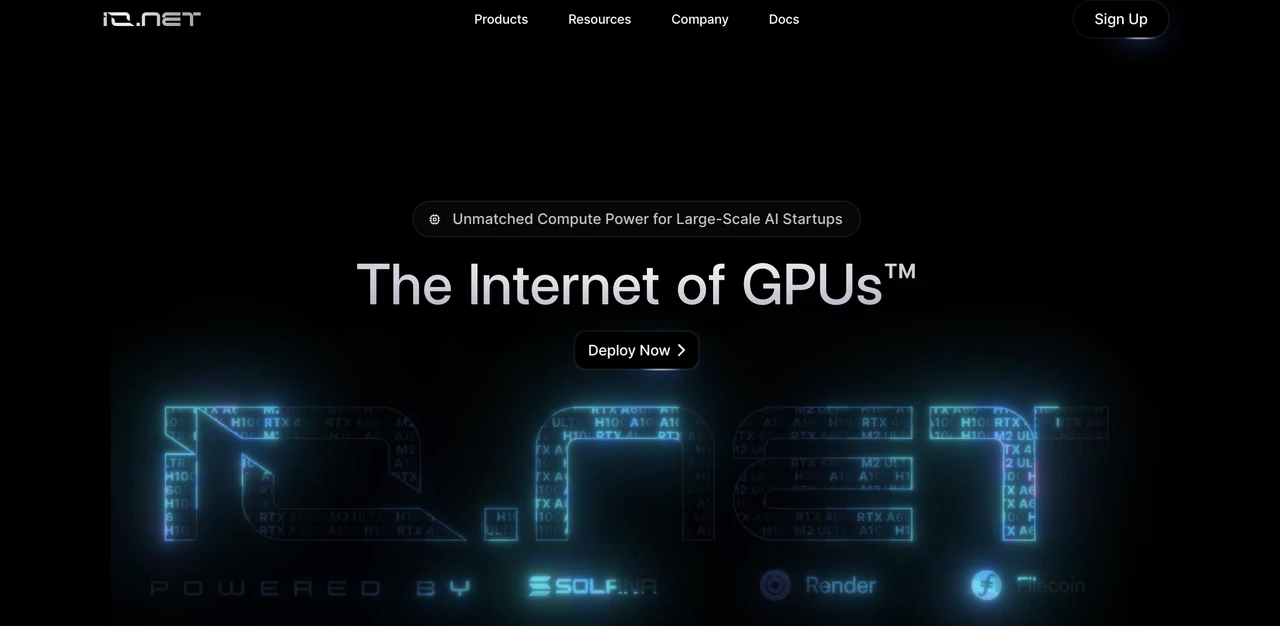
1. Project Overview
1.1 Business Summary
io.net is a decentralized GPU network designed to provide computing power for machine learning (ML). It aims to aggregate over one million GPUs from independent data centers, cryptocurrency miners, and projects such as Filecoin or Render to obtain computing power.
Its goal is to combine one million GPUs into the DePIN (Decentralized Physical Infrastructure Network) to create an enterprise-level, decentralized distributed computing network. By aggregating idle network computing resources globally (mainly GPUs at present), it aims to provide artificial intelligence engineers with more affordable, accessible, and flexible network computing resources.
For users, it serves as a marketplace for decentralized global idle GPU resources, allowing artificial intelligence engineers or teams to customize and purchase the GPU computing services they need according to their requirements.
1.2 Team Background

Ahmad Shadid is the founder and CEO, previously a quantitative system engineer at WhalesTrader.
Garrison Yang is the Chief Strategy Officer and Chief Marketing Officer, previously the Vice President of Growth and Strategy at Ava Labs.
Tory Green is the Chief Operating Officer, previously the COO of Hum Capital and Director of Corporate Development and Strategy at Fox Mobile Group.
Angela Yi is the Vice President of Business Development, a graduate of Harvard University, responsible for planning and executing key strategies such as sales, partnerships, and vendor management.
In 2020, Ahmad Shadid built a GPU computing network for the machine learning quantitative trading company Dark Tick. Due to the high-frequency nature of their trading strategies, they required a large amount of computing power, and the high cost of GPU services from cloud service providers became a challenge for them.
The significant demand for computing power and the high costs they faced led them to decide to create a decentralized distributed computing resource. Subsequently, they gained attention at the Austin Solana Hacker House. Therefore, io.net is a solution proposed by the team based on their own pain points, and they have implemented and expanded the business.
1.3 Product/Technology
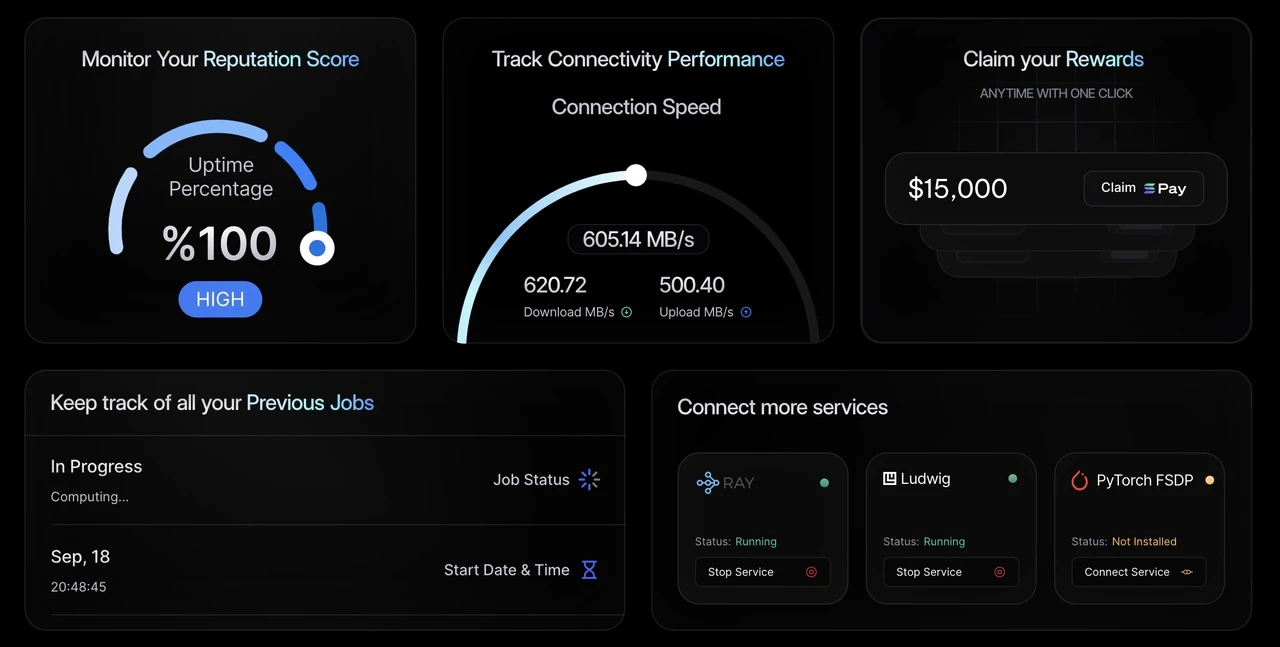
Issues faced by market users:
Limited availability - accessing hardware through popular cloud services such as AWS, GCP, or Azure typically takes weeks, and popular GPU models are often unavailable.
Limited choices - users have little flexibility in terms of GPU hardware, location, security level, latency, etc.
High costs - obtaining high-quality GPUs is very expensive, costing tens of thousands of dollars per month for training and inference.
Solution:
By aggregating underutilized GPUs (e.g., from independent data centers, cryptocurrency miners, and projects such as Filecoin and Render), io.net integrates these resources into DePIN, enabling engineers to access a large amount of computing power within the system. It allows ML teams to build inference and model service workflows across distributed GPU networks and utilize distributed computing libraries to orchestrate and batch training jobs, enabling data and model parallelism across many distributed devices.
In addition, io.net uses a distributed computing library with advanced hyperparameter tuning to check for optimal results, optimize scheduling, and simply specify search patterns. It also uses an open-source reinforcement learning library that supports production-grade, highly distributed RL (reinforcement learning) workloads and a simple API.
Product components:
IO Cloud - designed to deploy and manage decentralized GPU clusters on demand, seamlessly integrated with IO-SDK, providing a comprehensive solution for expanding artificial intelligence and Python applications. It provides unlimited computing power while simplifying the deployment and management of GPU/CPU resources.
IO Worker - provides users with a comprehensive and user-friendly interface to efficiently manage their GPU node operations through an intuitive web application. The product range includes functions related to user account management, monitoring of computing activities, real-time data display, temperature and power tracking, installation assistance, wallet management, security measures, and profitability calculations.
IO Explorer - primarily provides users with comprehensive statistical data and visualizations of various aspects of the GPU cloud, allowing users to easily monitor, analyze, and understand the complex details of the io.net network, providing comprehensive visibility into network activities, important statistics, data points, and reward transactions.
Product features:
Decentralized computing network - io.net adopts a decentralized computing model, distributing computing resources globally, thereby improving computing efficiency and stability.
Low-cost access - compared to traditional centralized services, io.net Cloud provides lower access costs, enabling more machine learning engineers and researchers to access computing resources.
Distributed cloud cluster - the platform provides a distributed cloud cluster, allowing users to choose suitable computing resources according to their needs and distribute tasks to different nodes for processing.
Support for machine learning tasks - io.net Cloud focuses on providing computing resources for machine learning engineers, enabling them to more easily perform tasks such as model training and data processing.
1.4 Development Roadmap

https://developers.io.net/docs/product-timeline
According to the information disclosed in the io.net whitepaper, the project's product roadmap is: January-April 2024, V1.0 comprehensive release, dedicated to decentralizing the io.net ecosystem, enabling it to achieve self-management and self-replication.
1.5 Financing Information
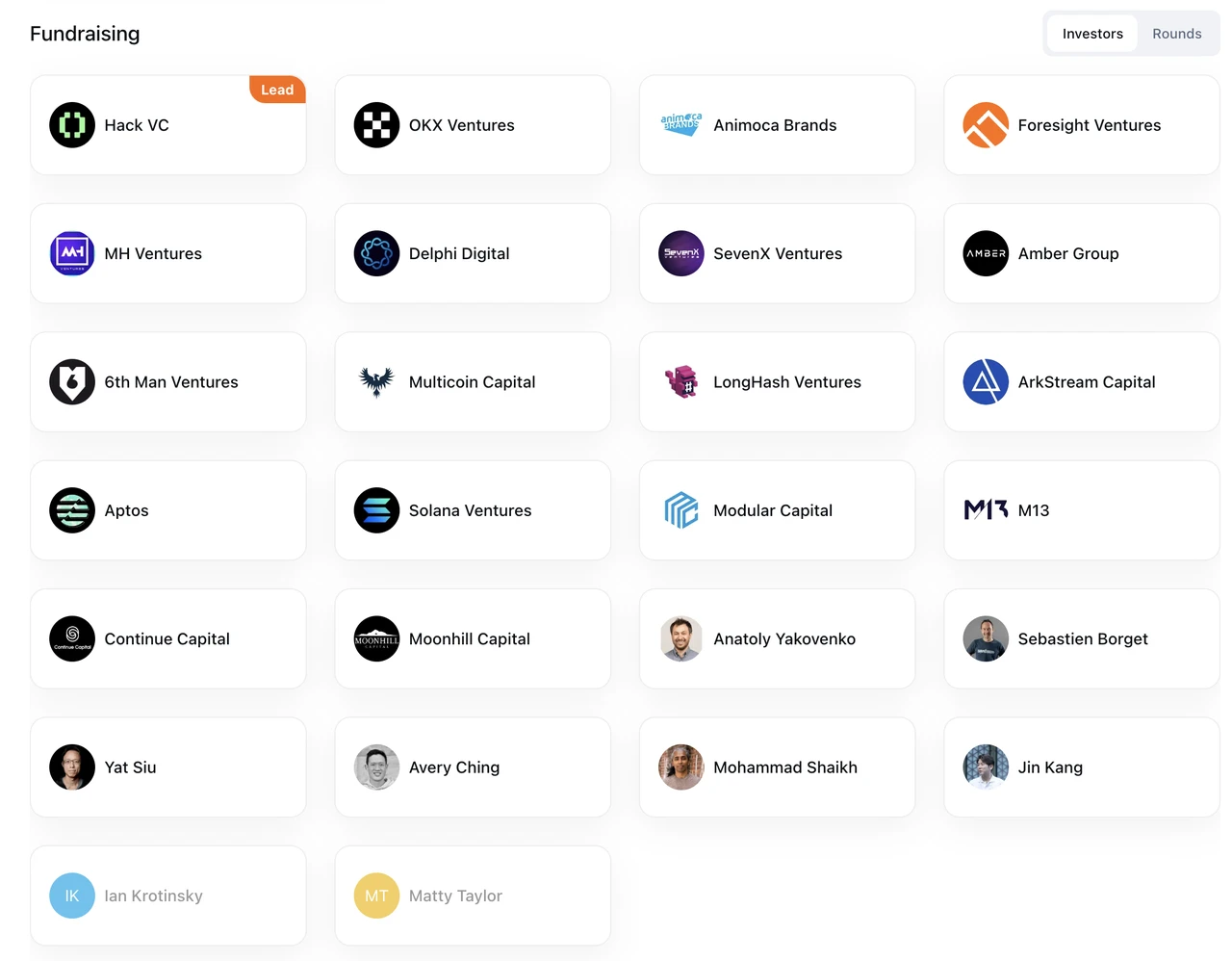
According to public news, on March 5, 2024, io.net announced the completion of a $30 million Series A financing round, led by Hack VC, with participation from Multicoin Capital, 6th Man Ventures, M13, Delphi Digital, Solana Labs, Aptos Labs, Foresight Ventures, Longhash, SevenX, ArkStream, Animoca Brands, Continue Capital, MH Ventures, Sandbox Games, and others. [1] It is worth noting that after this round of financing, the overall valuation of io.net is $1 billion.
2. Market Data
2.1 Official Website

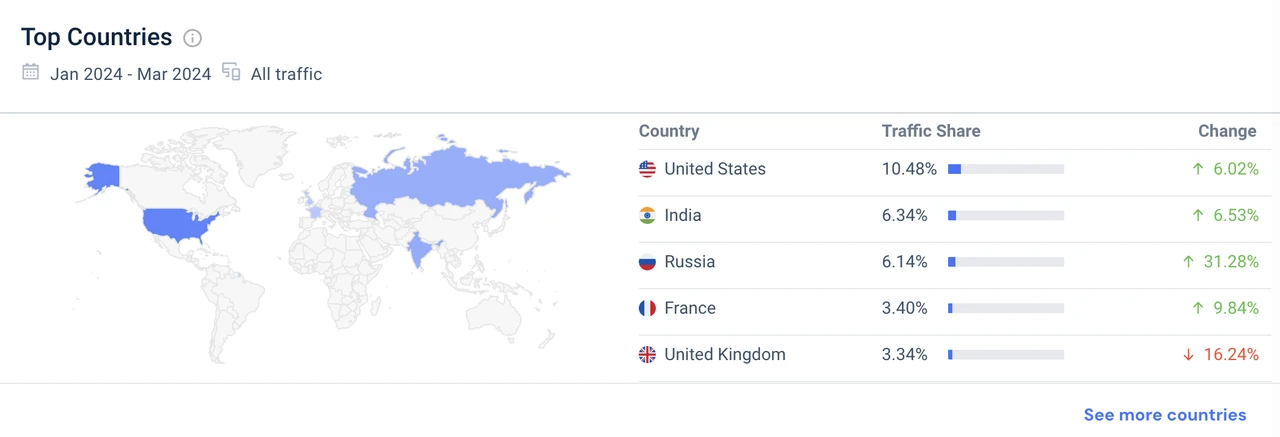
From January 2024 to March 2024, the official website data shows a total of 5.212 million visits, with an average of 1.737 million visits per month and a bounce rate of 18.61% (relatively low). User access data is fairly evenly distributed across regions, with direct and search visits accounting for over 80%, possibly indicating a low proportion of dirty data in the user access data. Users have a basic understanding of io.net and are willing to further explore and interact on the website.
2.2 Social Media Community

3. Competitive Analysis
3.1 Competitive Landscape
The core business of io.net is related to decentralized AI computing power, and its biggest competitor is traditional cloud service providers represented by AWS, Google Cloud, and Microsoft Intelligent Cloud (Azure). According to the "2022–2023 Global Computing Power Index Assessment Report" jointly compiled by International Data Corporation (IDC), Inspur Information, and the Global Industry Research Institute of Tsinghua University, the global artificial intelligence computing market is expected to grow from $19.5 billion in 2022 to $34.66 billion in 2026. [2]
In comparison to the sales revenue of major global cloud computing providers: in 2023, AWS had cloud service sales revenue of $9.08 billion, Google Cloud had sales revenue of $3.37 billion, and Microsoft Intelligent Cloud had sales revenue of $9.68 billion. [3] The market share of these three giants accounts for approximately 66% globally, and the market value of these three companies is all over a trillion dollars.
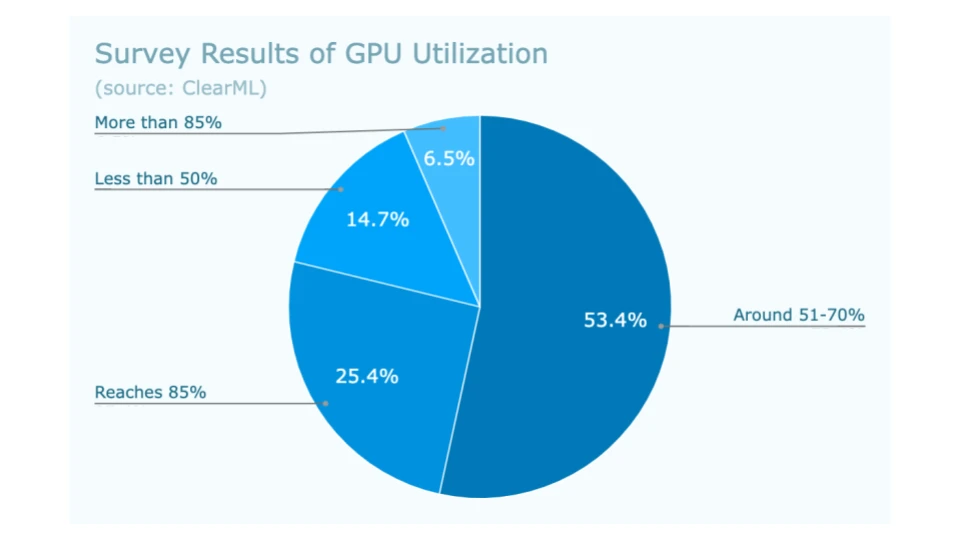
https://www.alluxio.io/blog/maximize-gpu-utilization-for-model-training/
In stark contrast to the high revenue of cloud service providers, the focus is on how to improve GPU utilization. According to a survey of AI infrastructure, most GPU resources are underutilized—around 53% of people believe that 51-70% of GPU resources are underutilized, 25% believe the utilization rate is 85%, and only 7% believe the utilization rate is over 85%. For io.net, the significant demand for cloud computing and the problem of underutilized GPU resources represent market opportunities.
3.2 Competitive Advantages
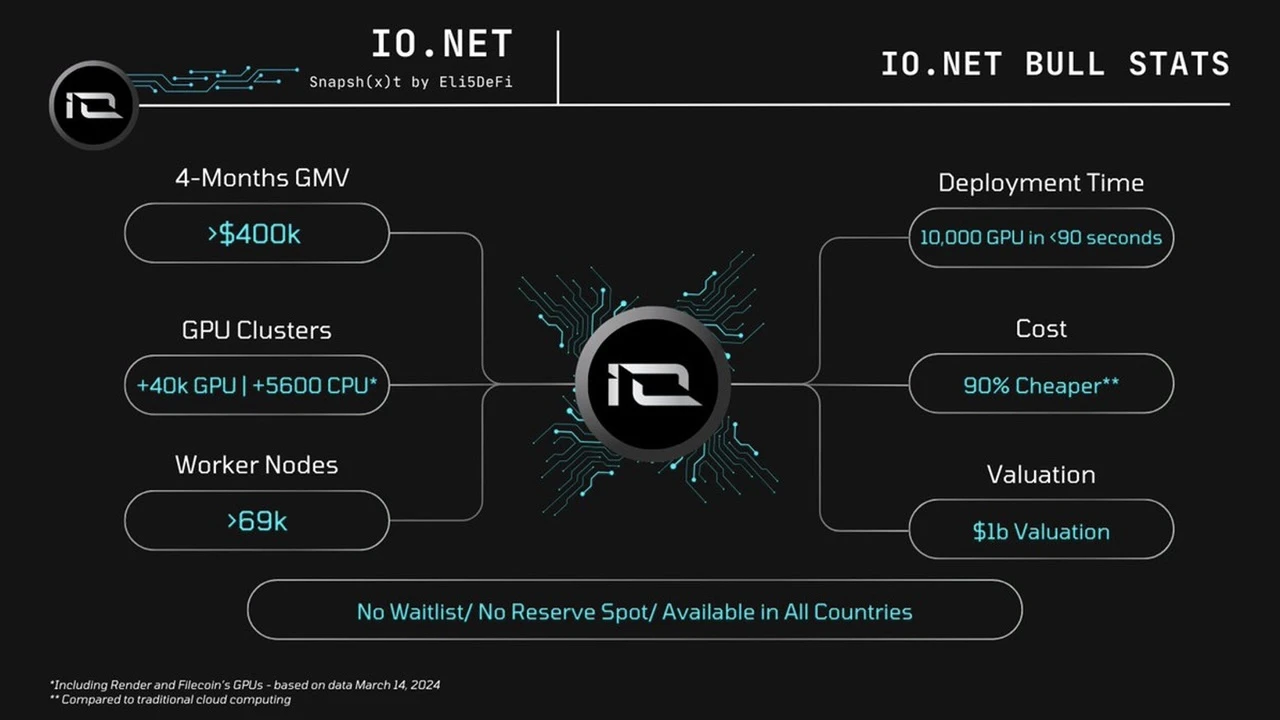
https://twitter.com/eli5_defi/status/1768261383576289429
The greatest competitive advantage of io.net lies in its ecological and first-mover advantages. According to official data: io.net currently has a total of over 40,000 GPU clusters, over 5,600 CPU units, and over 69,000 Worker Nodes. It can deploy 10,000 GPUs in less than 90 seconds and is 90% cheaper than its competitors, with a valuation of $1 billion. io.net not only provides customers with on-demand services at 10-20% of the cost of centralized cloud service providers without the need for permission, but also provides additional startup incentives for computing power providers through the upcoming IO token, jointly helping to achieve the goal of connecting 1 million GPUs.
In addition, compared to other DePIN computing projects, io.net focuses on GPU computing power, and its GPU network scale is already more than 100 times larger than similar projects. io.net is also the first in the blockchain industry to integrate the most advanced ML technology stack (such as Ray clusters, Kubernetes clusters, and giant clusters) into the GPU DePIN project and put it into large-scale practice, placing it in a leading position not only in terms of GPU quantity but also in technical application and model training capabilities.
As io.net continues to develop, if it can increase its GPU capacity to compete with centralized cloud service providers at 500,000 concurrent GPUs, it will be able to provide services similar to Web 2 at a lower cost and gradually establish its core position as a decentralized GPU network leader and settlement layer in the field through close cooperation with major DePIN and AI players (including Render Network, Filecoin, Solana, Ritual, etc.), bringing vitality to the entire Web 3xAI ecosystem.
3.3 Risks and Issues
io.net is an emerging computing resource integration and distribution platform deeply integrated with Web3, and its business overlaps significantly with traditional cloud service providers, posing risks and obstacles in both technology and market aspects.
Technical Security Risks - as an emerging platform, io.net has not undergone large-scale application testing and has not demonstrated the ability to prevent and respond to malicious attacks. The massive access, distribution, and management of computing power resources lack corresponding experience or practical verification, making it susceptible to common technical product issues such as compatibility, robustness, and security. Once problems arise, they could be fatal for io.net, as customers prioritize their own security and stability and are unwilling to bear the consequences.
Slow Market Expansion - io.net directly competes with traditional cloud service providers such as AWS, Google Cloud, and Alibaba Cloud, and even competes directly with second-tier or third-tier service providers. Although io.net has more favorable costs, its service and market systems for B-class customers are just beginning, which is significantly different from the current market operations in the Web3 industry. Therefore, its progress in market expansion is not ideal at the moment, which could directly impact its project valuation and token market performance.
Latest Security Incident
On April 25th, Ahmad Shadid, the founder and CEO of io.net, tweeted that the io.net metadata API had experienced a security incident. Attackers exploited the accessible mapping from user ID to device ID, resulting in unauthorized metadata updates. This vulnerability did not affect GPU access but did impact the display of metadata to users on the front end. io.net does not collect any PII and does not disclose sensitive user or device data.
Shadid stated that the io.net system is designed to self-heal, continuously updating each device to help restore any erroneously changed metadata. In light of this incident, io.net has accelerated the deployment of OKTA user-level identity authentication integration, which will be completed within the next 6 hours. Additionally, io.net has introduced Auth0 Token for user authentication to prevent unauthorized metadata changes. During the database recovery period, users will temporarily be unable to log in. All normal operating time records are unaffected, and this will not impact the computing rewards for suppliers.
4. Token Valuation
4.1 Token Model
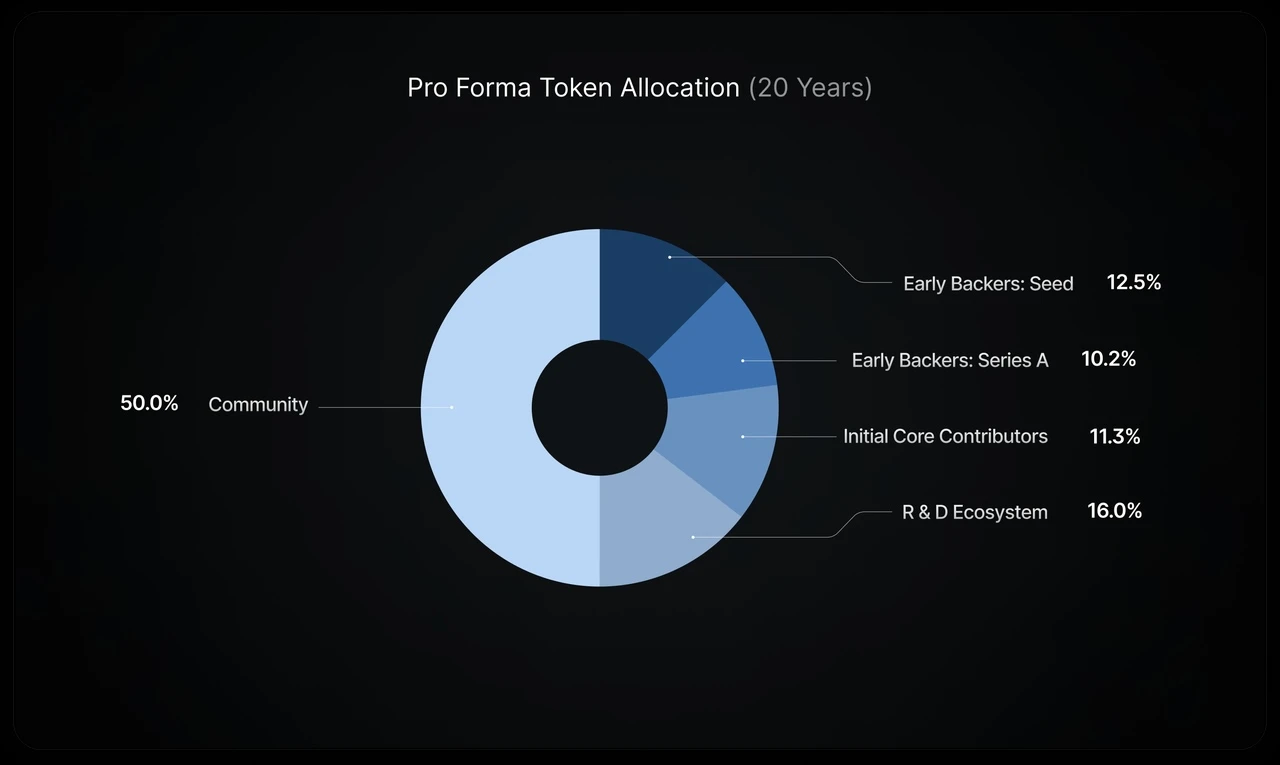
The io.net token economic model will have an initial supply of 500 million IO at its inception, divided into five categories: seed investors (12.5%), A-round investors (10.2%), core contributors (11.3%), research and ecosystem (16%), and community (50%). As IO issuance is used to incentivize network growth and adoption, it will grow to a fixed maximum supply of 800 million IO over 20 years.
The reward uses a deflationary model, starting at 8% in the first year and decreasing by 1.02% per month (approximately 12% per year) until reaching the 800 million IO limit. As rewards are distributed, the shares of early supporters and core contributors will continue to decrease, and after all reward allocations are completed, the community's share will increase to 50%.【4】
The utility of the token includes providing IO Worker allocation incentives, rewarding AI and ML deployment teams for continuous use of the network, balancing some demand and supply, pricing IO Worker computing units, and community governance.
To avoid payment issues due to IO coin price fluctuations, io.net has developed the stablecoin IOSD, pegged to the US dollar. 1 IOSD is always equal to 1 US dollar. IOSD can only be obtained by destroying IO. Additionally, io.net is considering mechanisms to improve network functionality. For example, it may allow IO Workers to increase their chances of being rented by pledging native assets. In this case, the more assets they invest, the greater their chances of being selected. Furthermore, AI engineers who pledge native assets can prioritize the use of high-demand GPUs.
4.2 Token Mechanism
The IO token is mainly used for two major groups: demand and supply. For demand, each computing job is priced in US dollars, and the network will hold the payment until the job is completed. Once node operators configure their reward shares in both US dollars and tokens, all US dollar amounts will be directly allocated to the node operators, while the share allocated to tokens will be used to burn IO coins. Then, during this period, all IO coins minted as computing rewards will be distributed to users based on the dollar value of their coupon tokens (computing points).
For supply, it includes availability rewards and computing rewards. Computing rewards are for jobs submitted to the network, where users can choose a time preference "the duration of cluster deployment in hours" and receive cost estimates from the io.net pricing oracle. Availability rewards involve the network randomly submitting small test jobs to assess which nodes run regularly and can accept jobs from the demand side.
It is worth mentioning that both the supply and demand sides have a reputation system based on computing performance and network participation to accumulate scores and receive rewards or discounts.
In addition, io.net has established an ecological growth mechanism, including pledging, referral rewards, and network fees. IO token holders can choose to pledge their tokens to node operators or users. Once pledged, the pledger will receive 1-3% of all rewards earned by participants. Users can also invite new network participants and share a portion of the new participant's future income. Network fees are set at 5%.
4.3 Valuation Analysis
We currently do not have accurate revenue data for projects in the same industry, so we cannot accurately estimate the valuation. Here, we mainly compare io.net with Render, which is also an AI+DePIN project, for reference.

https://x.com/ionet/status/1777397552591294797

https://globalcoinresearch.com/2023/04/26/render-network-scaling-rendering-for-the-future/
As shown in the comparison, Render Network is currently the leading project in the decentralized GPU rendering solution in the AI+Web3 industry, with a total of 11,946 GPU resources and a current market value of $30 billion (FDV $50 billion). io.net has 461,772 GPU resources, which is 38 times that of Render, and is currently valued at $1 billion. For both io.net and Render, the core key capability is decentralized GPU computing power. Therefore, based on the core comparison dimension of GPU supply, io.net's market value is likely to surpass Render's, at least on par.

https://stats.renderfoundation.com/
Render Network's Frames Rendered in 2022 was 9,420,335, with a GMV of $2,457,134. Currently, Render Network's Frames Rendered is 31,643,819, estimating the total GMV to be approximately $8,253,751.
In comparison, io.net's GMV over 4 months is $400,000. Assuming io.net maintains an average growth rate based on the 4-month GMV of $400,000, the 12-month GMV would be $1,200,000. If io.net were to reach the current GMV of Render Network, there is still a 6.8x growth potential. With io.net currently valued at $1 billion, based on the comprehensive analysis above, io.net's market value is expected to reach over $5 billion during a bull market cycle.
- Conclusion
The emergence of io.net has filled the gap in the decentralized computing field, providing users with a novel and potentially powerful computing method. With the continuous development of fields such as artificial intelligence and machine learning, the demand for computing resources is also increasing, making io.net have high market potential and value.
On the other hand, despite the market giving io.net a high valuation of $1 billion, its product has not been market-tested, and there are uncertain risks in terms of technology. Whether it can effectively match its supply and demand is also a key variable in determining whether its future market value can reach new highs. From the current situation, the achievements of the io.net platform on the supply side have been initially evident, but it has not fully exerted its efforts on the demand side, resulting in the overall GPU resources of the platform not being fully utilized. How to more effectively mobilize the demand for GPU resources is a challenge that the team must face.
If io.net can quickly access market-side demand and does not encounter major risks and technical issues during operation, with its physical business attributes of AI+DePIN, its overall business will start a growth flywheel and become the most eye-catching project product in the Web3 field. This also means that io.net will be a very high-quality investment target. Let's continue to follow up, observe, and carefully verify.
Reference Resources
【1】https://www.coincarp.com/fundraising/ionet-series-a/
【4】https://www.chaincatcher.com/article/2120813
All the above views are for reference only and not as investment advice. If there are objections, please feel free to contact for correction.
Follow and join the MIIX Capital community for more cutting-edge information:
Twitter: https://twitter.com/MIIXCapital_CN;
Telegram: https://t.me/MIIXCapitalcn;
Join the MIIX Capital team: hr@miixcapital.com
Open positions: Research Analyst / Operations Manager / Visual Designer
免责声明:本文章仅代表作者个人观点,不代表本平台的立场和观点。本文章仅供信息分享,不构成对任何人的任何投资建议。用户与作者之间的任何争议,与本平台无关。如网页中刊载的文章或图片涉及侵权,请提供相关的权利证明和身份证明发送邮件到support@aicoin.com,本平台相关工作人员将会进行核查。




